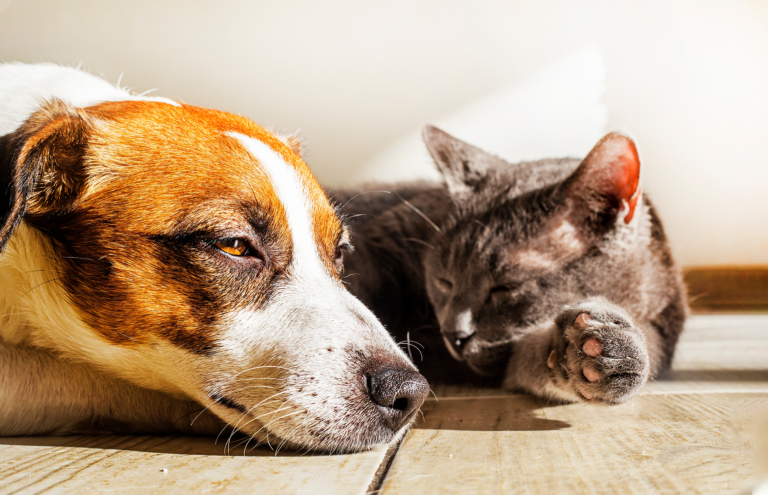The Advantage of Integrative Veterinary Care
Integrative and Holistic Nutrition
Research indicates that owning a pet is good for both physical and mental health, and pets are increasingly considered family members by many Americans.1,2 This has led to heightened interest and attention on diets for dogs and cats, including the addition of functional foods and supplements, as well as homemade diets.1
Examples of whole food ingredients commonly added to pet food include meats, fruits and vegetables, and whole grains in place of refined grains.3 The goal of adding whole food ingredients to the diet is to provide health benefits beyond the essential nutrients required by the animal, with the assumption that this will optimize the animal’s health and nutritional status.1
Can Animals Benefit from a Whole Food Advantage?
Benefits of food-based nutrients
Whole food ingredients provide a variety of essential macronutrients and micronutrients, including phytonutrients from plants. Thousands of micronutrients and phytonutrients possess properties that benefit human health including antioxidant, anti-inflammatory, and anti-cancer activities.1,3 In contrast, isolates from whole foods are usually highly processed, resulting in a significant loss of important nutrients.
Whole food ingredients also provide nutrients in the whole food matrix instead of as synthetic isolates or additives. Foods are not simply the sum of their components; food form, texture, and matrix affect nutrient bioavailability.5 Recently, researchers have started to better understand the role of the whole food matrix on important aspects of health including its ability to modulate absorption and digestion, affect satiation, and therefore influence energy intake.5 The consumption of whole foods results in slower digestion and decreased energy intake compared to highly processed foods. These impacts on digestion and energy intake can enhance metabolic health.5
Essential nutrients and phytonutrients in the whole food matrix work together to produce additional benefits, a concept called food synergy. This is the idea that the biological effect of consuming nutrients in the whole food matrix is greater than, or different from, the actions of the individual food components.4 For example, the bioavailability of vitamin A from a carrot increases when it is cooked in a healthy oil. This is due to the increased ability of the intestines to absorb fat-soluble vitamins when they are co-consumed with fat which increases their solubility and therefore accessibility to the body. Beyond providing more of the essential nutrients pets require, whole food ingredients provide them in the right form (whole food matrix) and optimal combinations (food synergy) — benefiting the entire body.
Improvements in clinical conditions
Epidemiology studies in humans as well as preclinical studies in animal models have demonstrated the synergistic effect of whole foods on conditions ranging from cardiovascular disease to cancer.3 These benefits extend to cats and dogs as well. For example, researchers found that dogs fed specific whole food ingredients exhibited better reproductive health, as well as improvements in behavioral disturbances.1 Whole food ingredients can also be used to target specific health concerns in dogs and cats.
Diets high in phosphorus may contribute to kidney dysfunction in cats and should be restricted in those with existing kidney issues.6 Inorganic phosphate salts commonly added to commercial pet food can cause an increase in plasma phosphorus concentrations in a dose-dependent manner.6 Alternatively, dietary phosphorus from natural food ingredients did not raise plasma phosphorus levels in a study evaluating whole food phosphorus in cats.6 Phosphorus in natural foods is likely bound to proteins as part of the whole food matrix, resulting in decreased bioavailability compared to phosphorus in inorganic salts which are readily absorbed.6
To combat weight gain, a common issue in dogs, pet owners may want to add whole food fiber into their dog’s diet. Inulin and oligofructose, two types of fibers, can modify the gut microbiome in dogs, promoting the growth of beneficial bacteria which then exert beneficial effects throughout the body, including through the production of short chain fatty acids.1,2 Additionally, soluble corn fibers can lower the glycemic and insulin response to food and improve intestinal health, while other sources of fiber such as rice bran contain many essential nutrients and phytochemicals with strong antioxidant and anti-inflammatory effects.2 Other actions of whole food fiber include:1-3,7
- Delaying gastric emptying and transit time, slowing digestion
- Reducing blood cholesterol levels
- Diluting calorie density, resulting in decreased caloric intake
- Increasing satiety
Together, these effects can greatly improve metabolic health, including mitigating weight gain, obesity, and diabetes.2,7
Safety considerations
The processing of commercial pet food can have a significant effect on digestibility, nutrient bioavailability, and even food safety.3 As such, it is important to weigh the benefits of dietary strategies to optimize the nutritional and health status of pets with safety concerns, cost, and convenience. While whole food ingredients provide many benefits, it is vitally important to ensure that diets for cats and dogs meet AAFCO standards for essential nutrients.
Meeting the nutritional needs of a dog or cat throughout a homemade diet can be very challenging, especially for micronutrients including iron, copper, zinc, and iodine.8 Some whole food ingredients, such as fiber, can bind to other dietary ingredients and therefore decrease absorption.2 Animals might also have unique needs due to medical conditions such as obesity or physiological needs from athletic training.3 It is critical that owners who choose to prepare their pet’s food at home adhere to food safety practices and consistently follow appropriate recipes in order to avoid recipe drift as that can lead to nutritional deficiencies over time.8
What is Integrative Veterinary Care?
Similar to the human world of medicine, some veterinarians utilize integrative, (w)holistic therapies including acupuncture, chiropractic manipulations, herb and nutritional supplements, and homeopathy.9 Typically, these veterinarians receive the same training as conventional veterinarians but seek additional training in integrative techniques. These practices typically include a multi-modal, whole-body approach that treats underlying issues instead of symptoms in isolation.9
Benefits of integrative treatments for animals
Integrative and (w)holistic treatment for animals can provide several benefits. First, it can help avoid potentially harmful drugs and unnecessary or ineffective surgeries. While pharmaceutical therapies and surgical interventions are very effective for certain conditions, alternative strategies can and should be utilized where appropriate to avoid such drastic, potentially unnecessary measures.9 Additionally, integrative veterinary care may provide adjunctive therapy for pets who are not responding to traditional treatments or strategies, possibly increasing the chances of successful recovery.10 More randomized, controlled studies are needed, but current clinical evidence points to a benefit of integrative techniques in reducing pain in animals as well as helping with lameness in models of joint pain.11-12 Together, integrative and conventional treatments can provide significant benefits to healthy pets as well as those with existing health conditions.
What Does the AAFCO Do?
The goal of the Association of American Feed Control Officials (AAFCO) Dog and Cat Food Nutrient profiles is to yield complete and balanced diets that nourish dogs and cats. AAFCO is responsible for setting nutritional standards for pet foods akin to dietary reference intake amounts for humans. These standards determine the minimum and maximum levels of about 30 nutrients that should be in pet foods based on studies regarding nutritional deficiencies and toxicities. Additionally, pet food labels can claim “natural” ingredients if they meet the regulatory definition; however, that definition allows for varying degrees of processing, genetically modified ingredients, and synthetic trace nutrients as long as they have nutritive value.3
Each step in the manufacturing or preparation of pet food can have an effect on the extent of “naturalness” in the final product, including crop and livestock production methods, ingredient processing, and kibble extrusion or canning.3,4 While kibble and canned foods often contain sufficient levels of essential nutrients to meet the AAFCO target, they may come from less natural sources, contributing to altered digestibility and physiological effect in the body.
- Di Cerbo, A., Morales-Medina, J.C., Pamieri, B., Pezzuto, F., Cocco, R., Flores, G., Ianniti, T. (2017). Functional foods in pet nutrition: Focus on dogs and cats. Res Vet Sci, 112:161.
- de Godoy, M.R.C., Kerr, K.R., Fahey, G.C. (2013). Alternative Dietary Fiber Sources in Companion Animal Nutrition. Nutrients, 5:3099.
- Buff, P.R., Carter, R.A., Bauer, J.E., Kersey, J.H. (2014). Natural pet food: A review of natural diets and their impact on canine and feline physiology. J Anim Sci, 92:3781.
- Jacobs, D.R., Gross, M.D., Tapsell, L.C. (2009). Food synergy: an operational concept for understanding nutrition. Am J Clin Nutr, 89(5):1543S.
- Forde, C.G., Bolhuis, D. (2022). Interrelations Between Food Form, Texture, and Matrix Influence Energy Intake and Metabolic Responses. Curr Nutr Rep, 11:124.
- Coltherd, J.C., Staunton, R., Colyer, A., Thomas, G., Gilham, M., Logan, D.W., Butterwick, R., Watson, P. (2019). Not all forms of dietary phosphorus are equal: an evaluation of postprandial phosphorus concentrations in the plasma of the cat. Brit J Nutr, 121:270.
- Richards, T.L., Rankovic, A., Cant, J.P., Shoveller, A.K., Adolphe, J.R., Ramdath, D., Verbrugghe, A. (2021). Effect of Total Starch and Resistant Starch in Commercial Extruded Dog Foods on Gastric Emptying in Siberian Huskies. Animals, 11:2928.
- Remillard, R.L. (2008). Homemade Diets: Attributes, Pitfalls, and a Call for Action. Top Companion Anim Med, 23(3):137.
- Pesch, L. (2014). Holistic pediatric veterinary medicine. Vet Clin North Am Small Anim Pract, 44(2):355.
- Vockeroth, W.G. (1999). Veterinary homeopathy: an overview. Can Vet J, 40(8):592.
- Pascoe, P.J. (2002). Alternative methods for the control of pain. J Am Vet Med Assoc, 221(2):222.
- Mittleman, E., Gaynor, J.S. (2000). A brief overview of the analgesic and immunologic effects of acupuncture in domestic animals. J Am Vet Med Assoc, 217(8):1201.









